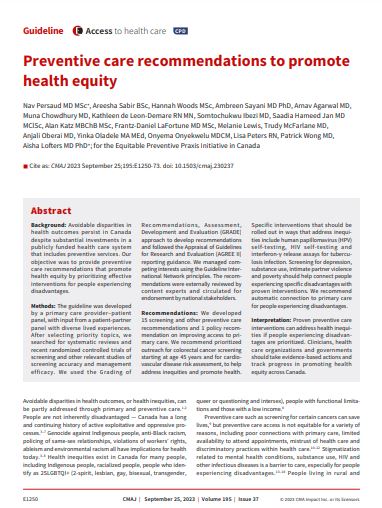Preventive care includes screening for certain cancers and heart conditions, blood testing for tuberculosis, self-testing for diseases like HIV and other practices to identify treatable conditions. Many people face barriers to accessing preventive care, such as Indigenous people, racialized people, people who identify as 2SLGBTQI+, people with functional limitations and those with low-incomes. Avoidable disparities in health outcomes persist in Canada despite substantial investments in a publicly funded health care system that includes preventive services.
We put together a decision tool, screening.ca, to help primary care professionals prioritize people for preventive care.
How we studied this
For this guideline we used systematic reviews of screenings and studies of health inequities to provide preventive care recommendations that promote health equity by prioritizing effective interventions for people experiencing disadvantages. We used this to develop 15 screening recommendations and 1 policy recommendation on improving access to primary care. The guideline is based on the latest evidence and involved input from people with lived experience and studies on patient values and preferences. These recommendations on preventive care complement policy recommendations to promote health equity.
Some of the key recommendations from the guide include:
- Colorectal cancer – prioritize colorectal cancer screening for patients starting at age 45 years (rather than the current recommendation of 50 years)
- Cervical cancer – offer self-testing to people eligible for cervical cancer screening
- Tuberculosis – the use of a blood test to screen for latent TB (rather than a skin test that requires several visits)
- Depression – screen for depression along with providing appropriate supports in adolescent and adults
- Poverty – in all families with children, screen for social risk factors, such poverty or the ability to afford basic necessities, and connect with resources and supports
- Primary care access – prioritize connection to primary care, with automatic enrollment in a primary care practice similar to the way children are automatically enrolled in local schools
Why this is important
Proven preventative care interventions can address health inequities if people experiencing disadvantages are prioritized. We recommend that clinicians, health care organizations and governments should take evidence-based actions and track progress in promoting health equity across Canada.


